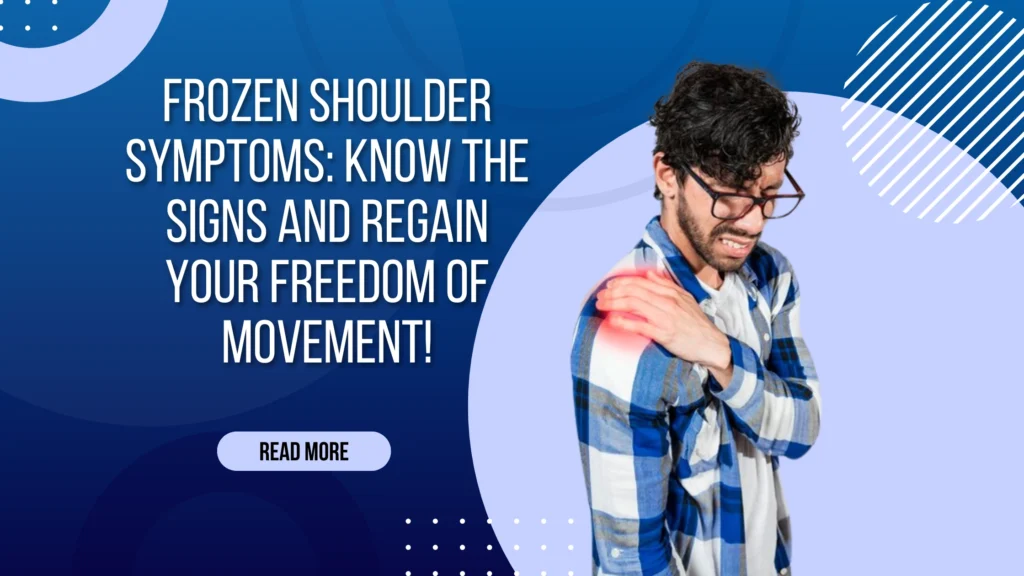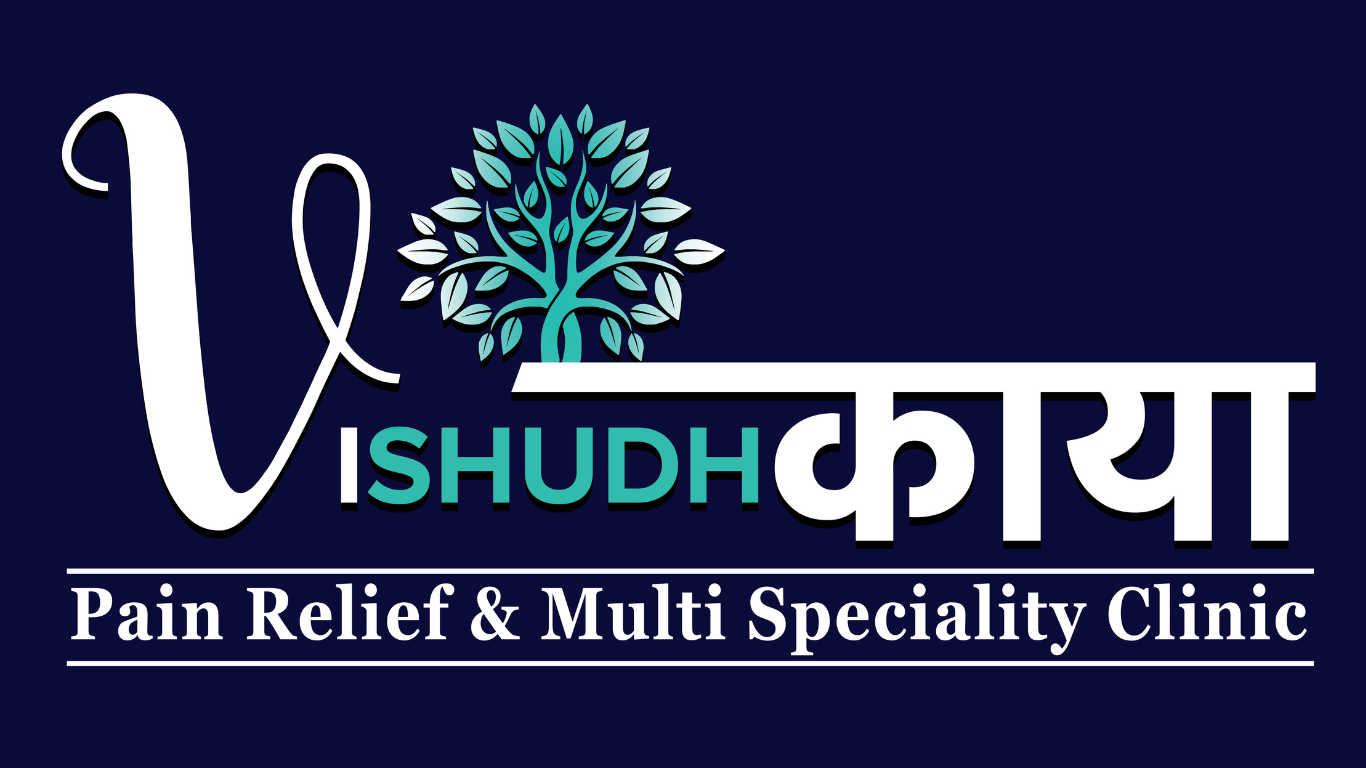INTRODUCTION
Frozen shoulder, or adhesive capsulitis, is a condition that causes increasing pain, stiffness, and limited movement in the shoulder joint. It develops gradually, restricting shoulder mobility and making routine activities more difficult. Recognizing the symptoms early is essential for effective treatment and a faster recovery. Without timely intervention, the pain and stiffness associated with a frozen shoulder can interfere with everyday tasks such as dressing, lifting, and sleeping comfortably.
This blog is here to guide you in identifying the early warning signs of a frozen shoulder, offering helpful insights into effectively restoring shoulder mobility and reducing discomfort. By understanding the symptoms and seeking timely treatment, you can regain the freedom of movement and avoid the long-term effects of this condition. The goal is to empower you with the knowledge you need to take control of your shoulder health, enabling you to return to your daily activities—whether it’s dressing, working, or enjoying physical activities—without the limitations and pain that a frozen shoulder can impose.
WHAT IS A FROZEN SHOULDER?
Adhesive capsulitis, also known as frozen shoulder, is a painful and persistent condition affecting the shoulder that lasts for more than three months. This condition causes inflammation and fibrosis of the glenohumeral joint capsule, leading to gradually increasing stiffness and a significant reduction in the shoulder’s range of motion, particularly in external rotation. Although symptoms may appear suddenly, the recovery process is slow and can take several years. Despite this, most patients eventually experience a full recovery, typically within two to three years.
ETIOLOGY
The exact causes of adhesive capsulitis are not fully understood, but certain factors are known to increase the risk of developing the condition. Secondary adhesive capsulitis typically develops following an injury or surgery that results in prolonged immobility of the shoulder. Primary (idiopathic) adhesive capsulitis, however, is associated with several underlying health conditions, including diabetes mellitus, stroke, lung disease, thyroid problems, heart disease, autoimmune disorders, and Dupuytren’s contracture. Both type 1 and type 2 diabetes are significant risk factors for this condition.
- Primary Adhesive Capsulitis (idiopathic) occurs without any identifiable cause and is more commonly seen in the non-dominant arm.
- Secondary Adhesive Capsulitis occurs when the condition develops after a shoulder injury or surgery, leading to limited mobility and the characteristic pain and stiffness. If a person is unable to move the shoulder for an extended period due to pain or immobilization (such as after surgery or an injury), the connective tissue around the joint may begin to thicken and tighten, leading to a frozen shoulder.
- Underlying Health Conditions – Several medical conditions are associated with an increased risk of developing a frozen shoulder, including:
- Diabetes: People with diabetes, especially those with poor blood sugar control, have a higher risk of developing a frozen shoulder. The exact link is unclear, but it may involve changes in the tissue structure or inflammation.
- Thyroid Disorders: Both hypothyroidism (underactive thyroid) and hyperthyroidism (overactive thyroid) can increase the likelihood of developing a frozen shoulder.
- Heart Disease: Individuals with heart disease, particularly those who have had a heart attack, may experience a frozen shoulder due to the impact of heart problems on circulation or prolonged immobility.
- Parkinson’s Disease: This neurological condition can affect shoulder movement and contribute to the development of a frozen shoulder.
- Other Autoimmune Disorders: Conditions like rheumatoid arthritis or other systemic inflammatory diseases can increase the risk due to chronic inflammation in the body.
- Age and Gender
- Frozen shoulder most commonly affects people between the ages of 40 and 60.
- Women are more likely to develop frozen shoulder, particularly those with diabetes.
- Previous Shoulder Problems
Individuals who have had previous shoulder injuries, such as rotator cuff tears, or other shoulder conditions like tendinitis, are at higher risk of developing frozen shoulder.
- Inflammatory Process
An inflammatory process in the joint capsule may play a role in the condition. Inflammatory cytokines and other molecules can lead to thickening and fibrosis of the joint capsule, restricting movement.
- Immobilization or Lack of Use
Prolonged immobility of the shoulder, whether due to injury, illness, or surgery, can contribute to a frozen shoulder. Lack of movement leads to the stiffening of the joint capsule and the surrounding tissue.
While these factors are believed to contribute to the onset of a frozen shoulder, the exact sequence of events leading to the condition can vary between individuals. Understanding these risk factors can help with early detection and management.
KEY SYMPTOMS OF FROZEN SHOULDER
Frozen shoulder (adhesive capsulitis) presents with three main symptoms: pain, stiffness, and limited mobility, which develop gradually and worsen over time.
Key Symptoms
- Pain:
- Felt in the outer shoulder and sometimes the upper arm.
- Dull and aching, but can become sharp with certain movements.
- Often intensifies at night, making it difficult to sleep, especially when lying on the affected shoulder.
- Triggered by activities such as lifting the arm, reaching overhead, or rotating the shoulder.
- Stiffness:
- Shoulder movement becomes progressively restricted.
- Both active (self-initiated) and passive (assisted) motions are limited.
- Everyday tasks like dressing, grooming, or reaching for objects become challenging.
- Reduced Range of Motion:
- Difficulty lifting the arm above the head, rotating it outward, or reaching behind the back.
- The loss of mobility typically develops slowly and can persist for months.
- Stage-Specific Symptoms:
- Freezing Stage (Painful Stage)
- Duration: 6 weeks to 9 months.
- Symptoms:Pain: The primary symptom in this stage. Pain is typically dull and aching at rest but becomes sharp with shoulder movements. Pain is more intense at night, often disrupting sleep. The pain gradually increases over time, making it difficult to perform shoulder movements. Any attempt to move the shoulder, even slightly, may exacerbate the discomfort. Over time, the pain discourages movement, which begins the cycle of stiffness .Stiffness starts to develop, though the shoulder still has some range of motion.
- Impact: Activities that require arm elevation, rotation, or reaching behind the back become increasingly uncomfortable.
- Cause: Inflammation of the joint capsule leads to thickening of the tissue and the development of adhesions, restricting mobility.
- Frozen Stage (Stiffening Stage)
- Duration: 4 to 6 months.
- Symptoms:
- Stiffness: This becomes the dominant symptom as the shoulder “freezes.”
- Movements like raising the arm, rotating it outward, or reaching behind the back become extremely restricted.
- Both active (self-initiated) and passive (assisted) movements are limited.
- Pain: Pain often decreases compared to the freezing stage but persists with movement and extreme positions.
- There is minimal or no improvement in the range of motion during this phase.
- The shoulder feels “locked,” making even basic tasks like dressing, grooming, or carrying objects very difficult.
- Impact: Severe limitations in shoulder mobility led to challenges in performing routine activities. Many people adapt to using the unaffected arm for most tasks.
- Cause: Thickened and tight connective tissue further restricts the shoulder joint’s movement, and adhesions within the capsule intensify stiffness.
C. Thawing Stage (Recovery Stage)
- Duration: 6 months to 2 years (depending on the severity of the condition and treatment).
- Symptoms:
- Improved Mobility: The shoulder’s range of motion begins to improve gradually.
- Movements like lifting, reaching, and rotating the arm become easier over time.
- Reduced Stiffness: The stiffness starts to resolve as the adhesions loosen and the joint capsule softens.
- Minimal Pain: Pain continues to decrease or disappears entirely as mobility improves.
- Muscle strength may still be slightly reduced due to disuse during earlier stages, but this improves with physical therapy and exercise.
- Impact: Shoulder functionality returns gradually, and most people recover close to their full range of motion, though some may experience lingering mild stiffness.
- Cause: The inflammation subsides, and the thickened tissues around the shoulder joint begin to heal and loosen, allowing greater mobility.
RISK FACTORS AND WHO IS AT RISK – Several factors can increase the risk of developing a frozen shoulder (adhesive capsulitis). These include medical conditions, demographic factors, and lifestyle influences. Here’s a detailed look at the most common risk factors:
1. Age and Gender
- Age: Frozen shoulder is most common in people aged 40 to 60 years.
- Gender: Women are more likely to develop frozen shoulders than men, with the risk being particularly high in postmenopausal women.
2. Medical Conditions
- Diabetes: People with diabetes, especially type 1 diabetes, have a significantly higher risk of developing a frozen shoulder. Poor blood sugar control is thought to contribute to inflammation and thickening of the joint capsule. Up to 20% of diabetic patients may develop frozen shoulder.
- Thyroid Disorders: Both hypothyroidism and hyperthyroidism are linked to an increased risk.
- Cardiovascular Disease: Conditions like heart disease or a history of a heart attack may contribute to the development of a frozen shoulder, possibly due to inflammation or changes in circulation.
- Parkinson’s Disease: Neurological conditions like Parkinson’s can limit shoulder movement and increase the risk of a frozen shoulder.
- Other Autoimmune or Inflammatory Conditions: Disorders such as rheumatoid arthritis or lupus can increase the likelihood due to chronic systemic inflammation.
3. Immobilization or Reduced Shoulder Use
- Injury: Shoulder injuries, such as fractures, dislocations, or rotator cuff tears, can lead to a frozen shoulder if the joint is immobilized for a prolonged period.
- Surgery: Post-surgical immobilization (e.g., after shoulder, breast, or heart surgery) can restrict shoulder movement, increasing the risk.
- Prolonged Immobilization: Lack of shoulder movement due to any reason (e.g., stroke, prolonged bed rest) can lead to stiffness and a frozen shoulder.
4. Previous Shoulder Problems
A history of shoulder issues, such as tendinitis, bursitis, or a previous frozen shoulder, raises the risk of recurrence, either in the same or the opposite shoulder.
5. Lifestyle and Habits
- Sedentary Lifestyle: Lack of physical activity or prolonged periods of inactivity can predispose someone to joint stiffness and a frozen shoulder.
- Repetitive Strain: Activities that cause repetitive strain or improper use of the shoulder may contribute to inflammation and adhesions over time.
6. Genetic Predisposition
There may be a hereditary component, as frozen shoulder appears to run in families in some cases, particularly among those with diabetes.
7. Trauma or Injury
Any trauma or significant injury to the shoulder joint can increase the risk, especially if it leads to reduced mobility during recovery.
8. Psychological Stress
Chronic stress and mental health conditions, such as depression or anxiety, may indirectly increase the risk by contributing to poor posture, inactivity, or reduced awareness of body mechanics.
WHY EARLY DIAGNOSIS IS CRUCIAL?
Recognizing a frozen shoulder in its early stages is key to managing the condition effectively and ensuring a quicker, more seamless recovery. Here’s why it matters:
- Prevention of Worsening Symptoms
- Stopping Progression: Early detection of a frozen shoulder can help prevent it from advancing through its painful and restricting phases.
- Managing Pain: Early treatment can help reduce inflammation and ease pain, preventing it from disrupting daily activities or sleep.
- Preventing Severe Stiffness: Addressing the issue early on can help maintain the shoulder’s range of motion, reducing the functional limitations that develop in the later stages.
- Easier Recovery with Early Intervention
- Benefits of Physical Therapy: Early diagnosis enables timely physical therapy, which plays a crucial role in preserving and improving shoulder movement.
- Reducing Complications: Early intervention can lower the risk of long-term issues like permanent stiffness or muscle weakness due to lack of movement.
- Quicker Healing: Early treatments, including anti-inflammatory medications, stretching, and corticosteroid injections, can shorten the healing period and speed up recovery.
- Avoiding Surgery: In more severe cases, surgery may be required. However, early treatment can often prevent the need for surgical intervention.
Treatment Options for Frozen Shoulder
Non-Surgical Approaches for Frozen Shoulder
Physical Therapy and Stretching:
- Focuses on regaining shoulder mobility and reducing stiffness through specific stretches and strengthening exercises.
- Aims to enhance flexibility, alleviate pain, and prevent further limitation of movement.
Chiropractic and Osteopathic Treatments:
- Chiropractic Care: Involves spinal and joint adjustments to realign and reduce shoulder pain.
- Osteopathic Adjustments: Uses manual techniques to improve circulation, relieve inflammation, and increase shoulder movement.
Ayurvedic and Homeopathic Solutions:
- Ayurvedic Treatments: Utilizes herbal remedies, oils, and therapies such as massage to reduce swelling and promote recovery.
- Homeopathic Remedies: Employs diluted natural substances to activate the body’s healing processes, easing pain and stiffness.
These non-invasive treatments help manage symptoms, improve shoulder function, and facilitate recovery without requiring surgery.
ADVANCED TREATMENTS AT VISHUDH KAYA PAIN RELIEF AND MULTISPECIALITY CLINIC
At Vishudh Kaya Pain Relief and Multispeciality Clinic, we offer a holistic and integrated approach to pain management by combining Chiropractic, Osteopathic, and Physiotherapy (COP) techniques. This unified method is designed to enhance mobility and alleviate pain through a combination of therapies:
- Chiropractic Care: Focuses on spinal and joint alignment through manual adjustments to improve posture, relieve discomfort, and restore function.
- Osteopathic Treatment: Utilizes hands-on techniques to enhance blood flow, reduce inflammation, and help the body heal naturally by manipulating joints and tissues.
- Physiotherapy: Employs specialized exercises, stretches, and therapeutic modalities to strengthen muscles, increase flexibility, and restore movement.
By merging these three effective approaches, the COP technique addresses both the causes and symptoms of pain, promoting a faster, more comprehensive recovery. This integrated therapy helps treat conditions like frozen shoulder, arthritis, and musculoskeletal pain without the need for invasive procedures.
Additionally, we offer personalized therapy plans designed to address the unique needs of each patient. Our team takes a detailed approach to understanding your specific condition, creating a customized plan that targets the root causes of pain and promotes long-term relief.
Our clinic is also known for its expertise in pain relief solutions for frozen shoulders, ensuring the best possible care for patients suffering from this condition. With our combined COP approach, we can effectively reduce pain, improve mobility, and support a faster recovery—without the need for invasive procedures.
Don’t let shoulder pain interfere with your daily life any longer! Book your consultation at Vishudh Kaya Pain Relief and Multispeciality Clinic today and take the first step toward a pain-free future. Our skilled team is highly experienced in treating shoulder pain, particularly frozen shoulder, using innovative methods like Chiropractic, Osteopathic, and Physiotherapy (COP) techniques to restore mobility and relieve discomfort. In addition, we provide Allopathy and Homeopathy treatments, offering a holistic approach to pain relief and recovery. Our comprehensive care ensures that you receive the best treatment tailored to your needs for a faster and more effective recovery. With flexible appointment options, we make it easy for you to access the expert care you need at your convenience. Reach out now to schedule your consultation and discover how we can help you regain strength, and flexibility, and improve your overall well-being!
Conclusion
Frozen shoulder, or adhesive capsulitis, is a condition characterized by pain, stiffness, and limited range of motion in the shoulder joint. Prompt diagnosis and treatment are essential for managing symptoms, preventing further limitations, and supporting a faster recovery. Non-surgical options, including physical therapy, chiropractic care, osteopathic adjustments, and natural remedies, are highly effective in reducing pain and improving shoulder mobility.
With the appropriate treatment, individuals with frozen shoulders can restore their shoulder function, enhance their quality of life, and minimize the need for surgery. Early and targeted intervention is crucial for achieving optimal outcomes and ensuring a quicker, more complete recovery.


